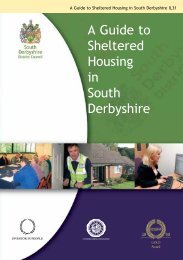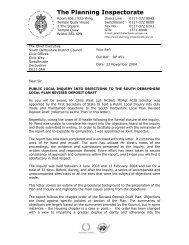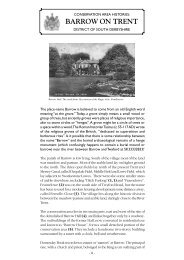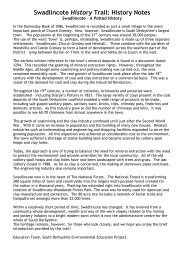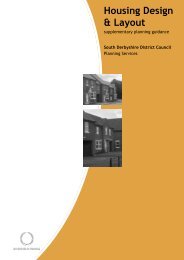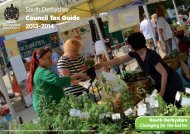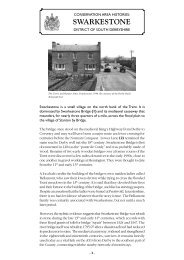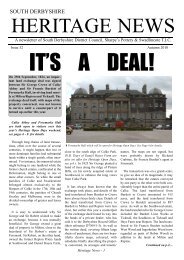Heritage news 21.pmd - South Derbyshire District Council
Heritage news 21.pmd - South Derbyshire District Council
Heritage news 21.pmd - South Derbyshire District Council
Create successful ePaper yourself
Turn your PDF publications into a flip-book with our unique Google optimized e-Paper software.
SOUTH DERBYSHIRE<br />
HERITAGE NEWS<br />
The design and heritage <strong>news</strong>letter of <strong>South</strong> <strong>Derbyshire</strong> <strong>District</strong> <strong>Council</strong> & Sharpe’s Pottery<br />
Issue 21<br />
Winter 2005/2006<br />
TOURISM BOOST FOR<br />
SWADLINCOTE<br />
“A Tourist Information Centre? In Swad?”<br />
The idea would have seemed scarcely<br />
thinkable just 20 years ago, but the fact that<br />
Swadlincote is now set to have a TIC at<br />
Sharpe’s Pottery is a potent symbol of the<br />
rapid development of <strong>South</strong> <strong>Derbyshire</strong> in<br />
recent times.<br />
The new TIC acknowledges Swadlincote’s<br />
strategic location in the National Forest,<br />
and the dramatic improvements made<br />
recently to the local environment of the<br />
town.<br />
It also demonstrates the growing interest<br />
in industrial archaeology over the last 20<br />
years, as shown by visitor attractions on<br />
the <strong>Derbyshire</strong>/Leicestershire border.<br />
These include Sharpe’s Pottery, Moira<br />
Furnace, Snibston Discovery Park, Hough<br />
Windmill and the Swannington Incline.<br />
Sharpe’s Pottery Trust Chairman John Oake<br />
says: “The Swadlincote TIC is a joint enterprise<br />
Grange Farm is a Winner!<br />
Local property developer Richard Blunt, who restored a decaying Georgian farmhouse at Overseal, was presented with<br />
a prestigious national award during a ceremony at Christie’s, London, on 1 st November.<br />
Grange Farm, which sits alongside the A444, was declared winner of the Georgian Group’s award for “Best Restoration<br />
of a Georgian Building in an Urban Setting”. In clinching the award, it drove off the strong competition of the National<br />
Trust’s project to restore a group of humble back-to-back houses in Birmingham.<br />
The handsome Grade 2 listed farmhouse, which at first sight could be taken for a Burton on Trent townhouse, boasts a<br />
handsome dining room, a library with built in shelves to all four walls, and a restored oak staircase. Currently on the<br />
market, it is hoped that its many charms will seduce a purchaser into making a family home of it once more.<br />
Speaking at the awards ceremony, the <strong>District</strong> <strong>Council</strong> Conservation officer Marilyn Hallard said:<br />
“Grange Farm sits on land criss-crossed by fissures and in 1992 a large hole appeared in the classified road in front of it.<br />
When that happened Grange Farm tilted, the then Coal Board promptly bought it and talked to us at the Local Authority<br />
about demolition. The movement was monitored over a couple of years and to everyone’s surprise the building stabilised.<br />
The Coal Authority was eventually persuaded to dispose of it and that is where Richard Blunt stepped in.” Richard, who<br />
had previously taken a keen interest in the equally notable “Overseal House” next door, devised a rescue package and<br />
completed the repairs earlier this year.<br />
<strong>Heritage</strong> News - 1<br />
with <strong>South</strong> <strong>Derbyshire</strong> <strong>District</strong> <strong>Council</strong>,<br />
consisting of several elements. The Sharpe’s<br />
museum entrance and shop area will be<br />
improved, specialist staff will be recruited and<br />
there will be improvements to the museum<br />
galleries.<br />
The current lack of road signage will be<br />
addressed through a brown sign scheme and<br />
town centre finger posting. We’re particularly<br />
looking forward to the installation of an<br />
innovative ‘through the glass’ touch screen<br />
system, giving 24-hour access to information<br />
about attractions, accommodation, events,<br />
etc.”<br />
Work is under way to make the Swadlincote<br />
Tourist Information Centre a reality in time for<br />
the start of the 2006 tourist season in April.<br />
• It was the proposed demolition of this<br />
attractive building of 1898 that triggered the<br />
designation of a conservation area in<br />
Swadlincote in 1990. Fifteen years later, the<br />
town is set to get a Tourist Information Centre<br />
as well.<br />
• Grange Farm
Staying Staying Put:<br />
Put:<br />
Wood ood oodville ood ville War ar<br />
Memorial<br />
Memorial<br />
The Woodville war memorial sits in an<br />
inconspicuous spot on Woodville High<br />
Street; a passer-by could easily miss it. It<br />
became a listed building earlier this year<br />
(see <strong>Heritage</strong> News no. 19), reflecting the<br />
interest that English <strong>Heritage</strong> has recently<br />
been taking in the preservation of war<br />
memorials generally.<br />
The Parish <strong>Council</strong>, deeming the current<br />
location of the memorial to be unsuitable,<br />
recently applied for listed building consent<br />
to move the war memorial to a more<br />
spacious location behind the Methodist<br />
Church. A public consultation was<br />
generally favourable to the idea, but local<br />
opinion was not unanimous. Some felt it<br />
was disrespectful to re-site the memorial.<br />
Objections, including those of English<br />
<strong>Heritage</strong>, led to a refusal of permission for<br />
the removal.<br />
The present position is that the war<br />
memorial is likely to stay on its current site,<br />
pending necessary repairs.<br />
From Hepworth’s to<br />
Morrison’s<br />
It is a strange experience to visit the former<br />
Hepworth’s site and see nothing behind<br />
Swadlincote High Street except flat land<br />
and a large hole in the ground where the<br />
Morrison’s supermarket is to be built. The<br />
listed chimney and the buildings attached<br />
to it now stand isolated, and <strong>South</strong><br />
<strong>Derbyshire</strong>’s last remaining beehive oven<br />
is no more.<br />
Even so, a walk across the site still reveals<br />
the remains of kiln bases and of broken<br />
bricks, pipes and toilets made on the<br />
premises. One such piece that I picked up,<br />
complete with its transfer-printed badge,<br />
turned out to be from Humpherson’s<br />
“Beaufort” closet first made in 1884 - the<br />
first, fully-fledged, modern ‘wash-down’<br />
loo.<br />
Work on the supermarket itself is due to<br />
start in the New Year, and the store is<br />
expected to open during the Autumn of<br />
2006.<br />
• What’s this? Answer on back page<br />
Thumbs up for Festival!<br />
The first Melbourne Festival took place back in September, blessed with mild, sunny<br />
weather. The town was alive with visitors, unanimous in their admiration for the event, if<br />
a little overwhelmed by the<br />
amount of material on show.<br />
Over 1,500 trail guides were<br />
sold and many visitors hit the<br />
trail on both days.<br />
Surprises for visitors (to<br />
mention but a few) included<br />
impromptu lute performances<br />
in the appropriate setting of the<br />
tithe barn, traditional (i.e.<br />
‘politically incorrect’) Punch<br />
and Judy, and the breathtaking<br />
sight of spirited metal<br />
sculptures in the Dower House<br />
garden against the backdrop of<br />
Melbourne Pool. Here was a<br />
splendid opportunity for<br />
education, entertainment, or<br />
simply for invited nosiness on • Feeding the ducks and swans at Melbourne Pool<br />
private property, made respectable with a permit.<br />
The 2006 Melbourne Festival will take place from Saturday 8 th to Sunday 17 th September.<br />
There will be a programme of concerts & lectures in the evenings (separately ticketed)<br />
and a weekend trail over the 16 th and 17 th September. As in 2005, art and other exhibitions<br />
will be hosted in private houses, churches, chapels, halls and community buildings, many<br />
of them Grade II listed and not normally open to the public.<br />
The Festival Committee has taken account of the successful and less successful aspects<br />
of this year’s experience and intends to modify the content accordingly. The Trail itself<br />
will be the same size geographically with new host houses, about the same number of<br />
painters, but more potters, jewellers, milliners and sculptors. As one 11 year-old said in<br />
2005, “Mum, paintings are great but I’ve seen quite enough for today thanks”.<br />
Excavated kiln is still a mystery!<br />
Over at Sharpe’s Pottery, the steel-framed<br />
warehouse of 1928 alongside Alexandra<br />
Road has been taken down. The owners of<br />
the site wished to reduce the ground levels<br />
where the building stood, which is<br />
beneficial for the pottery buildings as it will<br />
help to divert the surface water that<br />
occasionally floods the Sharpe’s Pottery<br />
buildings.<br />
• James Whitaker of Sharpe Bros. and Co. Ltd. (right) and an archaeologist,<br />
photographed as the remains of the kiln began to come to light.<br />
It was known, however, that the remains<br />
of structures from an early phase of the<br />
pottery’s history would almost certainly be<br />
discovered during the work, and we have<br />
not been disappointed. Careful uncovering<br />
<strong>Heritage</strong> News - 2<br />
of the remains, funded by the site owners<br />
and done by them in conjunction with an<br />
archaeological contractor, has revealed the<br />
base of a small 19 th century kiln, and part<br />
of the base of one of the original kilns of<br />
1821. As expected, there has been no<br />
shortage of shattered toilets, urinals,<br />
basins, teapots (especially teapot lids!),<br />
mixing bowls and banded yellow ware.<br />
Interestingly, little<br />
or no mocha ware<br />
has been found on<br />
this part of the site<br />
so far.<br />
The function of the<br />
kiln that has been<br />
found is open to<br />
debate. Even<br />
Marilyn Palmer, a<br />
well-respected<br />
industrial<br />
archaeologist<br />
based in<br />
Leicestershire, was<br />
mystified. It is<br />
much smaller than<br />
a conventional<br />
kiln, and the doors<br />
ways into it are oddly placed. It is expected<br />
that the remains will be preserved in situ,<br />
as the ground levels can be reduced to the<br />
required gradient without disturbing them.
“No Pool! No Village!”<br />
Between the Clock Garage at<br />
Woodville and the Maurice Lea<br />
Memorial Park at Church Gresley lies<br />
a desolate area with its centre at Pool<br />
Village, where there is now neither<br />
pool nor village. Much of the land is<br />
in an intermediate state, reclaimed<br />
from opencasting and mineral<br />
extraction, but in an unproductive<br />
condition pending redevelopment.<br />
The area is the subject of a special study<br />
currently being carried out by the <strong>District</strong><br />
<strong>Council</strong>, with the aim of identifying, listing<br />
and interpreting all potential<br />
archaeological sites there. This work will<br />
feed into future work undertaken for the<br />
“Woodville to Swadlincote Town Centre<br />
Area Action Plan”, and will help to ensure<br />
that due account is taken of archaeological<br />
matters within the planning process.<br />
Readers may be interested in a few<br />
snippets of information from the study:<br />
The site occupied by the present T. G.<br />
Green factory, and by Ensors on the other<br />
side of the railway line, is the bed of a large<br />
pond known as the Windmill Pool, formerly<br />
the property of the Gresleys of Drakelow.<br />
It was also known as the Upper Pool, to<br />
distinguish it from the “Lower Pool”<br />
downstream. The purpose of both pools<br />
was apparently to drive Gresley Mill,<br />
further downstream<br />
The stream that was dammed to form the<br />
Windmill Pool was once the county<br />
boundary, but eventually the water level<br />
on the southern edge of the pool came to<br />
be recognised as the boundary instead. It<br />
is interesting to note that, some 180 years<br />
after the pool was drained, its old surface<br />
water level still forms the county boundary<br />
today! The area remained marshy, so T.<br />
G. Green devised his own system of piled<br />
foundations to overcome the problems<br />
when his new works was built c1880: “He<br />
employed his own labour force and<br />
directed operations in his typically<br />
forthright manner, using a remarkable<br />
vocabulary of oaths that gave him the<br />
nickname “swearing Tom”.” (Paul<br />
Atterbury, in Cornish Ware and Domestic<br />
Pottery by T. G. Green (2001).<br />
T. G. Green’s Top Bank, represented today<br />
by the premises of Neville Lumb, also has<br />
interesting origins. Originally, this spot was<br />
enclosed out of Gresley Common to<br />
provide a house for the warrener who<br />
looked after the rabbit warren on the<br />
common. It was quite usual for commons<br />
to house colonies of commercially-farmed<br />
rabbits. A rabbit warren could be quite<br />
lucrative to the lord of a manor, who would<br />
rent it out or employ a warrener directly.<br />
• Part of Burdett’s map of <strong>Derbyshire</strong> (1791 edition), showing the Windmill Pool half way up<br />
on the right, and the lower pool by the mill house to the south. The black dot above the<br />
Windmill Pool represents the Warrener’s house on Gresley Common.<br />
The low hill that provides the focal point<br />
of Pool Village was known as Windmill<br />
Hill. The windmill that crowned it is long<br />
gone and its precise site is lost.<br />
However, the following snippet shows<br />
that it must have stood close to the<br />
warren house, that later became part of<br />
Green’s “Top Bank”:<br />
“During the summer months a<br />
flock of sheep belonging to<br />
Cooper and Massey grazed on the<br />
common as well as cows, horses,<br />
donkeys and geese belonging to<br />
the commoners. One mound<br />
known as the Warren, on which at<br />
some time a windmill stood, was<br />
covered with bracken and<br />
infested with rabbits”<br />
(H. J. Wain in Burton Observer<br />
and Chronicle, 26 th August, 1977)<br />
Such mounds are commonly associated<br />
with “post mills”, timber-framed and<br />
boarded structures which were sometimes<br />
built on a mound to catch more wind. Post<br />
mills were very common in the 18 th century<br />
and could, with some trouble, be<br />
dismantled and re-erected on a different<br />
site if necessity demanded. Artificial “pillow<br />
mounds” might also be made on rabbit<br />
warrens to encourage the rabbits to<br />
burrow, but the dual-purpose mound on<br />
Windmill Hill, serving both windmill and<br />
rabbits, was presumably a chance<br />
occurrence rather than a deliberate<br />
contrivance!<br />
<strong>Heritage</strong> News - 3<br />
One of the most famous (and most<br />
unusual) warren houses in England is the<br />
Triangular Lodge at Rushton,<br />
Northamptonshire, built c1593 and now in<br />
the care of English <strong>Heritage</strong>.<br />
We don’t know for sure when the Warren<br />
House at Gresley first became a pottery,<br />
but it was probably around 1790. The<br />
origins of the domestic pottery industry in<br />
Church Gresley as a whole still remain a<br />
little obscure; the industry certainly<br />
gathered momentum during the 1790s,<br />
but we may discover that its origins go<br />
back a decade or two beyond that.<br />
• The Rushton Triangular Lodge, Northants,<br />
once a warrener’s house. The warrener’s house<br />
on Gresley Common, by contrast, would have<br />
been a plain affair.
Keith Foster writes:<br />
It has been a busy time in the Attic over the last few months,<br />
preparing for exhibitions and publishing new books.<br />
We were invited to The Arboretum at Alrewas on 15th August to<br />
show our “Soldiers of WW2” exhibition. The day was organised<br />
mainly to commemorate VJ day<br />
and to open a new permanent<br />
exhibition dedicated to<br />
Prisoners of War in the Far East<br />
– this is well worth a visit and<br />
includes descriptive panels,<br />
photographs, drawings and<br />
other artefacts relating to<br />
experiences of the prisoners<br />
(www.cofepow.org.uk). We<br />
were also invited back to The<br />
Arboretum on Armistice Day<br />
(11/11) to again show the same<br />
exhibition.<br />
The Civic Trust’s <strong>Heritage</strong><br />
Open Days (8 th – 11 th Sept.) -<br />
when many properties normally<br />
closed to the public are open –<br />
was another busy time for us.<br />
The Attic arranged three separate exhibitions, one at the old<br />
factory of T. G. Green in Church Gresley, one at the Methodist<br />
Chapel in West Street, Swadlincote and the third in the Attic<br />
itself. All were well attended – especially the T. G. Green factory<br />
- perhaps as this was possibly the last opportunity for a visit.<br />
In conjunction with the National Forest Co.’s LANDshapes<br />
project (www.landshapes.org) we have mounted two<br />
Marian Adams writes:<br />
News from the Magic Attic<br />
An exciting new project has recently got off the ground<br />
at Gresley Old Hall near Swadlincote, where members<br />
of <strong>South</strong> <strong>Derbyshire</strong>’s Mining Preservation Group have<br />
embarked on a journey of discovery into the Arts.<br />
Artist Rob Webster and writer Marian Adams, who are<br />
supported by People Express, have been commissioned<br />
to develop creative ways of expressing Mining <strong>Heritage</strong><br />
and Stories, which will be celebrated and reflected in a<br />
permanent sculpture to inspire and inform future<br />
generations.<br />
Over a six-week period, mine workers and their families<br />
will contribute to – and create - the finished piece, which<br />
will be sited at Rosliston Forestry Centre.<br />
“After the chicken comes the old hen”.<br />
Do you know what this means? No? Ask a miner!<br />
• High Street Swadlincote, 1906, as drawn recently by Steve Sharp.<br />
Underground Overground<br />
• A practical sculpting session at Gresley Old Hall, to develop themes for the<br />
finished piece. Left to right: Rob Webster (artist), Roger and Pauline Ward<br />
and Jim Harrison.<br />
<strong>Heritage</strong> News - 4<br />
photographic exhibitions in Swadlincote – one at the Library<br />
and the other on the 19 th Nov in our premises at Sharpe’s Pottery<br />
Museum.<br />
The Magic Attic has recently purchased a new printer especially<br />
for the production of local<br />
history books. It has been kept<br />
busy and we are now offering<br />
three new and previously<br />
unpublished titles (“Life and<br />
Times in Old Moira”, “The<br />
Pioneering People of<br />
Melbourne” and “<strong>Derbyshire</strong>’s<br />
Agricultural <strong>Heritage</strong>”). We<br />
have also completed a reprint<br />
of the classic 1980s study of<br />
Hartshorne “At the Sign of the<br />
Bull’s Head”. We are quite<br />
proud of all these titles and<br />
reviews of them can be read<br />
elsewhere in this issue of<br />
<strong>Heritage</strong> News.<br />
One of our more exciting<br />
recent “finds” has been a local<br />
artist, Steve Sharp, who has created a number of pencil drawings<br />
of local sites of interest. Three of his drawings are of Moira and<br />
together with authors of “Life and Times in Old Moira” we<br />
arranged a signing at Moira Furnace on the 19 th Nov.<br />
All the above books and limited edition prints are now available<br />
at The Attic. Other outlets are being arranged.
New Books<br />
The Pioneering People of Melbourne<br />
and the Surrounding <strong>District</strong><br />
G. R. Heath, published by the Magic Attic,<br />
Swadlincote, 2005. 62pp, £9.00.<br />
Melbourne has encouraged newcomers,<br />
fostered residents and enjoyed the success<br />
of those who left but maintained the pride<br />
of their birthplace. This publication is an<br />
attempt to record the progress of some of<br />
those people important to the Parish of<br />
Melbourne, straying to record a few just<br />
beyond the parish boundary.<br />
The personalities covered are a diverse and<br />
colourful bunch, from all ranks of society.<br />
Here are tales of self-made Victorian<br />
figures such as Thomas Cook the Travel<br />
Agent, John Borlase Warren of Cincinnati<br />
and J. G. Shields of Donington Park, as<br />
well as the lives of local aristocracy and<br />
gentry.<br />
• Thomas Cook the Travel Agent<br />
Not all are success stories, as the book<br />
actually includes a few men who “came<br />
undone”. William Dexter, for instance, was<br />
indeed a talented painter but led a<br />
Bohemian existence and was not so<br />
successful in other areas of his life, which<br />
was cut short in Australia. And it is<br />
questionable whether Laurence 4th Earl<br />
Ferrers of Staunton Harold should be<br />
included as a “pioneer”; his progress in life<br />
went downhill rather than up, terminating<br />
in his execution at Tyburn in 1760 with a<br />
rope wrapped in silk, for the murder of his<br />
steward.<br />
<strong>Derbyshire</strong>’s Agricultural <strong>Heritage</strong>:<br />
Series 1. Articles and photographs<br />
reproduced from the <strong>Derbyshire</strong> Advertiser<br />
July 1910 – July 1911.<br />
Compiled by Eric and Beryl Tunstall,<br />
published by the Magic Attic, Swadlincote,<br />
2005. 114pp, £10.75.<br />
This publication is of a simple but effective<br />
formula, being a series of articles about<br />
individual farms and the men who farmed<br />
them 95 years ago. The articles are wellillustrated<br />
with photographs of the<br />
farmsteads, farmers and livestock and are<br />
full of interest. It is sad that the<br />
photographs are only of the original<br />
<strong>news</strong>print quality, as the original<br />
photographic material would be a treasure<br />
in its own right. Assuming that it no longer<br />
exists, we have to make the best of what is<br />
left.<br />
The farms covered are spread across<br />
<strong>Derbyshire</strong>, with a few examples in<br />
Staffordshire and Leicestershire as well.<br />
Several are in <strong>South</strong> <strong>Derbyshire</strong> including<br />
Derby Hills Farm, Egginton Dairy, Gould’s<br />
Farm at Willington, Grange Farm at<br />
Weston on Trent, Dale Farm at Willington<br />
and Grange Farm at Barrow on Trent.<br />
The title is a little misleading, as it implies<br />
a look back to the past from a present-day<br />
standpoint. In reality, this is a last<br />
contemporary gaze at the proud days of<br />
Victorian farming before the World Wars<br />
and mechanisation irrevocably changed it<br />
all. The articles are chattily and<br />
intelligently written with a good mixture<br />
of descriptive and factual information, and<br />
have that power to make the reader feel<br />
that he is experiencing these farms at first<br />
hand for himself. This is “series 1”; I<br />
presume we may look forward to more of<br />
the same in “series 2”.<br />
Life and Times in Old Moira by Ashby<br />
Woulds & <strong>District</strong> Local History Group,<br />
published by the Magic Attic, Swadlincote.<br />
112pp, £8.00.<br />
In the Furnace of c1804 (which survives)<br />
and the Stone Rows of c1811 (which<br />
don’t), Moira had two landmark features<br />
of great interest and historic importance.<br />
The book records the memories of those<br />
who lived in both places, among others.<br />
We are given a vivid insight into the hard<br />
but character-forming routines that most<br />
residents shared in common not so long<br />
ago – a life of tin baths hung out on the<br />
back wall, frugal Christmases, make do and<br />
mend, fetching water, travelling long<br />
distances on foot, hard manual labour and<br />
the occasional killing of the family pig. We<br />
are also introduced to the various social<br />
organisations, the local foundry and mines,<br />
and local dialect. Insofar as those subjects<br />
are concerned, “yo cudna esk frote betta”.<br />
The book is clearly written for a local<br />
audience, as revealed by phrases such as<br />
“Many readers will remember…”, and will<br />
find its main market among the local<br />
residents of the present day. But the content<br />
is wide-ranging and diverse enough to offer<br />
something for the rest of us, throwing light<br />
on this interesting industrial community<br />
through the ages.<br />
The relatively recent scope of the content<br />
should come as no surprise to those that<br />
know Moira, as there was nothing much<br />
there to speak of 200 years ago. The book<br />
does make reference to the earliest days of<br />
the village, but here it is less successful.<br />
The origins of Moira as a part of Ashby<br />
Woulds, developed after the enclosure of<br />
the Woulds, are not adequately explained,<br />
nor are the Baths, and the histories of preenclosure<br />
features such as Barratt Mill and<br />
Pool do not take account of all the available<br />
evidence. And while the book notes that<br />
<strong>Heritage</strong> News - 5<br />
“Much has been written about the Moira<br />
Furnace and its history”, a summary<br />
sentence or two of useful history would<br />
have taken little more space, for the benefit<br />
of a reader unfamiliar with it.<br />
Some of the other content is inconsistent<br />
in the level of detail included. “Chapters”<br />
range from a single paragraph each to a<br />
chapter on the school which occupies a<br />
third of the book. But the prospective<br />
purchaser should not be put off. This is a<br />
document of social history, and makes no<br />
pretence at being a comprehensive history<br />
of Moira. There is plenty here to entertain,<br />
amuse and instruct the reader for several<br />
happy hours.<br />
At the Sign of the Bulls Head: A History<br />
of Hartshorne and its Enclosure. Edited<br />
by Janet Spavold and published by the<br />
<strong>South</strong> <strong>Derbyshire</strong> Local History Research<br />
Group, 1984. Re-printed, with minor<br />
amendments and corrections, by the Magic<br />
Attic, Swadlincote, 2005. 154pp, £14.95.<br />
Many will welcome a renewed chance to<br />
buy this popular and well-regarded study<br />
of Hartshorne, first produced 21 years ago.<br />
It was the result of original research which<br />
will not be found published elsewhere. The<br />
same group produced two other books<br />
which also remain essential reading for<br />
local historians in the area: “Pits, Pots and<br />
People: <strong>South</strong> <strong>Derbyshire</strong> in 1851” (1981)<br />
and “In the Name of God Amen: Everyday<br />
Life in <strong>South</strong> <strong>Derbyshire</strong> 1535-1700”<br />
(1992).<br />
The central theme of the Hartshorne study<br />
is the Parliamentary Enclosure of the<br />
common and open fields of Hartshorne in<br />
1765-66, which involved redistribution of<br />
land and new roads, thus paving the way<br />
for the creation of the modern landscape.<br />
But there is far more to this study than that.<br />
The book hones in on the history of<br />
indivudal families, houses and farmsteads,<br />
and among other things explores the<br />
workings of Hartshorne’s well-known<br />
screw mill (now the Mill Wheel<br />
Restaurant). Not least among the buildings<br />
is the Bulls Head Inn itself, once kept by<br />
Gilbert Raven, and the place where the<br />
enclosure commisioners met to deliberate<br />
the enclosure of the parish.<br />
• The Screw Mill at Hartshorne undergoing<br />
reconstruction, 1987 (Derby Daily Telegraph)
Sharpe’s<br />
Christmas Fayre<br />
John Oake writes:<br />
The weekend of 25th & 26th November<br />
marked Swadlincote’s traditional pre-<br />
Christmas Fair, with the switching on of<br />
the lights, a firework display on Friday<br />
evening and a street funfair across the<br />
two days.<br />
The management, staff and volunteers<br />
at Sharpe’s made great efforts to<br />
maximise the potential offered by the<br />
event, by staging a Victorian Christmas<br />
Fayre and Market throughout the two<br />
days.<br />
Attractions included a fairground organ,<br />
hog roast, hot chestnut seller and mulled<br />
wine, together with a strong contingent<br />
of our Farmers’ Market stallholders,<br />
crafters and fund raising stalls manned<br />
by the Volunteers for Sharpe’s Pottery.<br />
Our catering staff also put on a special<br />
menu, including a Friday evening ‘Bistro’<br />
meal.<br />
The Fayre was a resounding success<br />
for Sharpe’s, adding colour and vibrancy<br />
to one of Swadlincote’s top annual social<br />
occasions and bringing over 2,600<br />
visitors to the Museum in just two days.<br />
John Oake writes:<br />
On 29 th November, BBC1’s ‘Cash in the Attic’ featured<br />
the ‘de-cluttering’ of local collector and Sharpe’s<br />
supporter, Mrs. Pat Paling.<br />
Sharpe’s Majestic Empire Cinema<br />
A national initiative is currently being piloted to bring film screenings back to communities that<br />
are too small to support a commercial multi screen cinema. The main focus is on village halls, but<br />
Sharpe’s Pottery Museum has been chosen as the pilot location for <strong>South</strong> <strong>Derbyshire</strong>.<br />
Chairman John Oake says: “Our Conference Room (sponsored by <strong>Derbyshire</strong> Building Society) is<br />
equipped with a ceiling mounted projector, electric screen and sound system and we have decided<br />
to recall the names of Swadlincote’s two much-loved former cinemas in the title of the project, by<br />
calling it ‘Sharpe’s Majestic Empire Cinema’.<br />
• The former Majestic Cinema at Swadlincote (The Magic Attic)<br />
“We know that we can’t recreate the authentic cinema experience in the conference room, but<br />
hope to make up for that by creating a friendly ‘film club’ atmosphere. It should certainly be much<br />
more enjoyable to be out in company watching a film screening in the Sharpe’s environment than<br />
seeing a video or DVD at home.”<br />
Screenings have started in the run up to Christmas with a short programme of seasonal films<br />
screened on Saturday afternoons. Details of future screenings will appear in <strong>Heritage</strong> News and<br />
on the Sharpe’s events and activities calendar.<br />
Pat’s Pat’s Pots<br />
Pots<br />
Among the items identified for auction were a<br />
graduated set of three mid nineteenth century<br />
Sharpe’s Pottery ale jugs and two early Sharpe’s<br />
‘Rockingham’ glazed teapots. The ale jugs are<br />
particularly rare, being in superb condition and<br />
carrying Sharpe’s Pottery impressed marks, leaving<br />
• An advertisement for Sharpe’s Pottery, 1891.<br />
their place of manufacture in no doubt.<br />
Pat was anxious that the local items should end up in the Museum collection, so funding was provided through the Volunteers<br />
for Sharpe’s, enabling the Chairman to bid at the auction.<br />
There was considerable excitement and tension, as Pat’s items virtually doubled the expert’s pre auction valuation.<br />
Fortunately we were able to secure the items that we particularly wanted and they are now on display in one of the new<br />
cases, also provided by the ‘Volunteers’.<br />
Although we had to go beyond our original budget, it is encouraging to note the growing interest and value of <strong>South</strong><br />
<strong>Derbyshire</strong> collectable ceramics.<br />
<strong>Heritage</strong> News - 6
Sharpe’s Pottery Lecture<br />
Programme.<br />
In 2005, the <strong>District</strong> <strong>Council</strong> has begun to sponsor a programme of<br />
lectures at Sharpe’s Pottery, to further an appreciation of our local<br />
heritage. It is intended that the subjects covered should be wideranging<br />
and diverse; the only essential criterion is that the topic is in<br />
some way relevant to our local area, or as relevant to our area as to<br />
any other.<br />
To begin with, lectures have been limited to a “Spring lecture” and an<br />
“Autumn lecture”, which have both been well-attended. The Spring<br />
lecture was by Glyn Coppack on “The Archaeology of Monasteries”<br />
and the Autumn lecture was by David Eveleigh on “Bogs, Baths and<br />
Basins”. The established form is that the evenings begin with a<br />
reception at 7pm, when wine is on sale to the accompaniment of live<br />
music in the kiln. The lectures then begin at 7.45pm.<br />
The Spring 2006 lecture will be on the duties and dilemmas faced by<br />
churchwardens of the Church of England, and will be given by Dr.<br />
David Marcombe of Nottingham University on March 29 th . As there<br />
appears to be an appetite for these lectures, a series of four or five is<br />
planned for the winter season 2006-2007. So far, we have lined up<br />
Linda Hall, who will tell us how houses can be dated from such small<br />
features as doorknobs and hinges; Danny Wells who will speak on<br />
(Thomas) Cook’s Tours; and Jeremy Barlow, who will speak on the<br />
illustration, music and history of nursery rhymes (with musical<br />
demonstration!).<br />
We intend that there should be something for everyone in the<br />
programme of lectures we present.<br />
• A diagram of the ingenious water closet patented by Joseph<br />
Bramah (1748 - 1814) in 1778.<br />
Alan Kimber writes:<br />
News from Repton<br />
Repton Village History Group (www.reptonvillage.org.uk) has launched its latest<br />
publication “Notices and Jottings from St. Wystan’s, Repton Parish Magazine<br />
1889-1937". It is a 105 page volume of extracts taken from the magazines and<br />
provides an interesting insight into the life of the village in those days. It covers<br />
both national and local events as well as copies of advertisements from the early<br />
editions. Edited by Gill Hiley, it is available from Sharpe’s Pottery and The Magic<br />
Attic in Swadlincote, Ottakers in Burton, Derby Cathedral Bookshop and Repton<br />
Post Office. The price of £4.95 makes it an ideal present.<br />
On Saturday and Sunday 1 st & 2 nd April, we plan to hold a major 2-day exhibition<br />
of our archives. It will include an extensive photographic display covering Repton,<br />
Milton, Foremark and Ingleby, slide shows and many items from our large collection<br />
of documents including the Census Returns. Our publications will be available<br />
for purchase. Doors will be open from 10am till 5 pm each day.<br />
<strong>Heritage</strong> News - 7<br />
- Curiosity Corner -<br />
Ancient and Modern…<br />
The Trent at Twyford, meaning the “double ford”, could still be<br />
crossed by a chain ferry as recently as 1963, when the boat<br />
was washed away in floods. This photograph contrasts the<br />
archaic ferry with the chimneys of the “new age” power station<br />
at Willington. The two subjects seem worlds apart in time, but<br />
are captured here together on a photograph taken during their<br />
brief co-existence. Until Victorian times, Swarkestone Bridge<br />
formed the only roadway connection between the southern<br />
extremity of <strong>Derbyshire</strong> and the rest of the County north of<br />
Trent. Willington Bridge, originally a toll bridge, was opened<br />
in 1839 and the Midland Railway viaduct was built over the<br />
river between Melbourne and Weston in 1867. Other crossing<br />
points were provided by fords and ferries, all long abandoned<br />
with the ascendancy of motor vehicles.<br />
• The Ferry on the River Trent at Twyford<br />
( Brighouse Collection / www.picturethepast.org.uk)<br />
<strong>South</strong> <strong>Derbyshire</strong> Mining<br />
Preservation Group<br />
If you are interested in our local mining<br />
heritage, the Mining Preservation Group<br />
would be pleased to welcome you. The<br />
Group Secretary, Monica Hudson, says:<br />
“Our aim is to collect and preserve all we<br />
can of the mining heritage of this area. The<br />
collection of tools, books, photographs and<br />
multi-media is held at Gresley Old Hall and<br />
we meet every first Thursday in the month.<br />
We also take our collection out and about<br />
in the community to Schools, Village Halls<br />
and Galas. Why not join us? Everyone is<br />
welcome!” Monica can be contacted on<br />
01283 225729.
January<br />
Forthcoming events at Sharpe’s Pottery.<br />
To book events requiring tickets or reservations, please telephone Sharpe’s on 01283 222600.<br />
Artists of the Month: Erica Middleton and Sue Clews, painters, in the Coffee Shop, 9 th –31 st Jan.<br />
Saturday 14 th , 10am – 4pm Farmers’ Market in the Courtyard. Admission Free.<br />
February<br />
Artists of the Month: Joanne Sheppard and Jemma Rix, painters, in the Coffee Shop, 1 st – 28 th Feb.<br />
Saturday 4 th , 10am – 3pm Carolyn Bates Floral Masterclass, £12 per person, including buffet lunch.<br />
Tuesday 14 th Valentines Night event (supper and a film, the film<br />
sponsored by Visage Hairdressers), details to be announced.<br />
Saturday 18 th , 10am – 4pm Farmers’ Market in the Courtyard. Admission Free.<br />
Saturday 18 th “The Viking Coaches” – a booksigning day by Harry Twells, in the kiln.<br />
Admission Free.<br />
Monday 20 th , 10am – 4pm Over 8’s Half Term Craft Day with Angela Hudson: “Up, Up & Away!” £10.00<br />
(children to bring own lunch or bring money to spend in the coffee shop).<br />
Tuesday 21 st , 10am – 4pm Over 8’s Half Term Craft Day with Angela Hudson: “Dangerous Dinosaurs”<br />
£10.00<br />
(children to bring own lunch or bring money to spend in the coffee shop).<br />
Weds. 22 nd , 10am – 4pm Over 8’s Half Term Craft Day with Angela Hudson: “Mad Models” £10.00<br />
(children to bring own lunch or bring money to spend in the coffee shop).<br />
Saturday 25 th , 2pm Sharpe’s Saturday Afternoon Matinee. £3.00 (50 seats only). Film to be<br />
announced.<br />
March<br />
Artists of the Month: Jackie Palmer and Mary Byrne, painters, in the<br />
Coffee Shop, 1st – 31st March.<br />
Saturday 11th , 7.30pm Live music in the Kiln: “Bass-ically Music”<br />
by Fred Thelonious Baker, well known bass<br />
guitarist, tickets £6.00.<br />
Saturday 18th , 10am – 4pm Farmers’ Market in the Courtyard. Admission<br />
Free.<br />
Saturday 18th , 10am – 4pm Antiques Fair in the Conference Room.<br />
Admission Free.<br />
Saturday 25th , 2pm Sharpe’s Saturday Afternoon Matinee: “Best<br />
In Show”: (a film about wacky owners and their<br />
Wednesday 29<br />
pooches, sponsored by “The Pet Shop”, Swadlincote, to coincide with Crufts!).<br />
£3.00 (50 seats only).<br />
th • Fred Thelonious Baker<br />
, 6.45pm Sharpe’s History Lecture: “Churchwardens: Duties and Dilemmas” by Dr. David<br />
Marcombe.Tickets £4.50. Doors open 6.45pm; musical recital in kiln 7pm; lecture<br />
starts 7.45pm.<br />
April<br />
Mon 10 th – Fri 14 th , 10 – 4 Children’s Theatre Workshop with Angela Hudson. £50 for the week.<br />
Saturday 15 th , 10am – 4pm Farmers’ Market in the Courtyard. Admission Free.<br />
Thursday 20 th , 10am – 4pm Over 8’s Half Term Craft Day with Angela Hudson: “Battle Bots” £10.00<br />
(children to bring own lunch or bring money to spend in the coffee shop).<br />
Friday 21 st , 10am – 4pm Over 8’s Half Term Craft Day with Angela Hudson: “Dream Island” £10.00<br />
(children to bring own lunch or bring money to spend in the coffee shop).<br />
<strong>Heritage</strong> News -8
Recent research in the last few<br />
months has thrown new light on<br />
several historic buildings in our<br />
area.<br />
Foremark:<br />
Historic Buildings under the Spotlight<br />
We have Witan Archaeology to thank for<br />
a survey of Anchor Church at Foremark.<br />
It gets its name for the word “anchorite”<br />
= hermit, and was possibly once occupied<br />
in the Anglo Saxon period by St.<br />
Hardulph, patron saint of the church at<br />
Breedon on the Hill. Perhaps a thousand<br />
years later, the caves were turned into a<br />
picturesque retreat or summer house by<br />
the Burdetts of Foremark. Door and<br />
window frames were inserted, and a lime<br />
mortar floor; there was even a fireplace<br />
with a chimney.<br />
A print published in 1765 shows the site<br />
complete with a party of visitors. A man<br />
plays the flute to a small audience, while<br />
two others carry a picnic hamper. Dogs<br />
play on the grass, men fish, and women<br />
are attentive to their children. Boats ply<br />
the river while local village folk make hay<br />
in the meadows opposite.<br />
Sadly, it is a different scene today. All the<br />
joinery has gone and much of the floor<br />
has eroded away. Natural wear and tear<br />
account for this. Of greater cause for<br />
concern are the graffiti and spray paint<br />
which disfigure the walls. Nevertheless,<br />
this historic site remains atmospheric and<br />
is a Grade II listed building. The Witan<br />
Archaeology survey is a useful record of<br />
what now exists and provides a<br />
benchmark to monitor the condition of the<br />
caves in future.<br />
• Anchor Church, Foremark, engraved by Francois Vivares after a painting by Thomas Smith of<br />
Derby. Published 1765.<br />
Newton Solney:<br />
Over at Newton Solney, the editor has<br />
undertaken some new research in<br />
preparation for the forthcoming<br />
conservation area history leaflet. This<br />
work has shown that the course of events<br />
in the evolution of the park was<br />
substantially different to the story that is<br />
usually told. Previous accounts vary, but<br />
the general gist is that the park was bought<br />
by Abraham Hoskins the elder of Burton<br />
on Trent, who built a new<br />
house (now the Newton Park<br />
Hotel) c1798 and crowned<br />
the nearby hilltop with a<br />
huge folly called “Bladon<br />
Castle”, to be seen from the<br />
house.<br />
Closer inspection (both of<br />
the buildings and<br />
documentary evidence)<br />
casts grave doubts on this,<br />
and is slowly revealing a<br />
different story. The man<br />
behind it all was not Hoskins<br />
the elder at all, but his son<br />
Abraham Hoskins the<br />
<strong>Heritage</strong> News -9<br />
younger (c1759-1842). Hoskins acquired<br />
the first part of his estate at Newton<br />
Solney in 1798, excluding the site of the<br />
present hotel building which, it seems,<br />
was not part of his initial vision.<br />
Apparently, his intention at the time was<br />
to build a new house on Bladon Hill,<br />
where he later built his folly.<br />
For some reason, Hoskins abandoned his<br />
plan to build a house on the hill, and built<br />
Bladon Castle there instead, probably in<br />
1805. Meanwhile, in 1800, he had bought<br />
a farm on the edge of Newton Solney<br />
village from the Every estate, adjoining<br />
the land acquired in 1798. Perhaps he had<br />
intended to install a manager there, but<br />
eventually Hoskins decided to remodel<br />
the farmhouse as his own principal<br />
residence. This is the house that is now<br />
the Newton Park hotel, shorn of its<br />
extensive farm buildings in the mid 19 th<br />
century. Early photographs, once the<br />
property of the Ratcliff family, show the<br />
house as it stood after Hoskins’<br />
remodelling, but before extensive<br />
alterations were made around 1880.<br />
The resulting park is strange, as the<br />
Newton Park Hotel is visually<br />
disconnected from the main body of its<br />
own parkland. It was a desire to<br />
understand the peculiar layout of the park<br />
that stimulated the new research in the<br />
first place. The road in front of the house<br />
was moved further away in 1809, and the<br />
farm buildings at the back were removed<br />
to another site before 1877, but the house<br />
was never made to appear as a convincing<br />
centrepiece to the park. That role still<br />
belongs to Bladon Castle, which was<br />
eventually converted to a house but was<br />
always the secondary house of the<br />
Hoskins estate.<br />
Continued on page 10<br />
• Bladon Castle (Brighouse Collection /<br />
www.picturethepast.org.uk)
Swadlincote:<br />
Unlike the previous two buildings,<br />
Hearthcote House at Swadlincote no longer<br />
exists, but the <strong>District</strong> <strong>Council</strong> was<br />
recently made aware of some recording<br />
work that was undertaken by the County<br />
<strong>Council</strong> when the house was demolished.<br />
The County <strong>Council</strong>’s Sites and<br />
Monuments Record Officer has kindly<br />
scanned the relevant sketch plans, detail<br />
sketches and photographs onto a CD for<br />
us.<br />
There is some doubt as to whether this<br />
house was the manor house of Hearthcote,<br />
listed in Domesday as a separate place from<br />
Swadlincote, or was simply a farmhouse<br />
belonging to the manor. It was not a large<br />
house; it had two storeys plus attics and a<br />
stone-lined cellar, and just three rooms on<br />
the ground floor. But manor houses were<br />
not always large, and its quality suggested<br />
a house of relatively high status. Had it<br />
survived just a few years longer, it would<br />
almost certainly have become a listed<br />
building.<br />
In 1838 Hearthcote House belonged to a<br />
modest farm of 68 acres rented by Francis<br />
Allen from his landlord S. P. Wolferstan<br />
Esq. In the 18th century the farm was<br />
occupied by the Newbold family.<br />
Hearthcote is one of a group of “-cote”<br />
(=cottage) names in <strong>South</strong> <strong>Derbyshire</strong>, the<br />
others being Swadlincote and Brizlincote.<br />
The name takes various forms such as<br />
Hedcote (‘d’ was sometimes pronounced<br />
‘th’), Harcoat, Hathcote and Heathcote, and<br />
probably means “heath cottage”.<br />
The internal walls of the house were timber<br />
framed and the balusters and handrail of<br />
the fine contemporary staircase suggested<br />
• Hearthcote House on the eve of its demolition, c1979 (<strong>Derbyshire</strong> County <strong>Council</strong>)<br />
a mid 17 th century date. The entire building<br />
was probably timber framed when first<br />
erected, except for the chimneystacks (of<br />
dressed stone blocks), but the external walls<br />
were later replaced in brick. A rubbing of<br />
the date 1793 on a brick or stone perhaps<br />
indicates when this was done, but we are<br />
not told exactly whereabouts on the<br />
building the date was found.<br />
The staircase balustrades, tenoned into two<br />
posts that ran up the whole height of the<br />
house, were craned out of the building in<br />
one piece and taken into store at Elvaston<br />
Castle. Sadly, a recent search there failed<br />
WE CAN HELP YOU WITH PUBLICITY<br />
“<strong>Heritage</strong> News” is published by <strong>South</strong> <strong>Derbyshire</strong> <strong>District</strong> <strong>Council</strong> three times a year around April/May (Spring/Summer issue),<br />
August (Autumn issue) and December (Winter issue). It is circulated to all parish councils / meetings, amenity societies and historical<br />
groups within <strong>South</strong> <strong>Derbyshire</strong>, and is also distributed to libraries and to local press contacts. We are always pleased to advertise the<br />
work of local groups where possible, so please call us with any <strong>news</strong> for our next issue. The deadline for inclusion in No. 22 (Spring/<br />
Summer 2006) is Friday 17 th March.<br />
Contacts:<br />
Philip Heath <strong>Heritage</strong> Officer / Editor of “<strong>Heritage</strong> News” tel: 01283 595936 fax: 01283 595850<br />
e-mail: philip.heath@south-derbys.gov.uk<br />
Marilyn Hallard Design & Conservation Officer tel: 01283 595747 fax: 01283 595850<br />
e-mail: marilyn.hallard@south-derbys.gov.uk<br />
Cordelia Mellor-Whiting Curator, Sharpe’s Pottery tel: 01283 222600<br />
e-mail: cordelia@sharpespotterymuseum.org.uk web: www.sharpes.org.uk<br />
The postal address is: <strong>South</strong> <strong>Derbyshire</strong> <strong>District</strong> <strong>Council</strong>, Civic Offices, Civic Way, Swadlincote, <strong>Derbyshire</strong> DE11 0AH. The <strong>District</strong><br />
<strong>Council</strong> has a website at www.south-derbys.gov.uk<br />
Note: The non-editorial contributions to “<strong>Heritage</strong> News” reflect the views of their authors and may not necessarily coincide with<br />
those of the <strong>District</strong> <strong>Council</strong>.<br />
Answer to question on page 2.<br />
A mirrored view looking up the Grade II listed landmark chimney at the Morrison’s site<br />
<strong>Heritage</strong> News -10<br />
to find any trace of them; it is thought that<br />
they may have been destroyed in a fire there<br />
some time ago. Today, Hearthcote is just a<br />
road name.<br />
A Better Way to Receive<br />
“<strong>Heritage</strong> News”?<br />
We would like to hear from anyone who<br />
is able to receive a .pdf version of<br />
“<strong>Heritage</strong> News” via e-mail to save costs<br />
and materials. If you are able and willing<br />
to receive <strong>Heritage</strong> News in this way,<br />
please send an e-mail to<br />
philip.heath@south-derbys.gov.uk and<br />
we will add you to the list.



